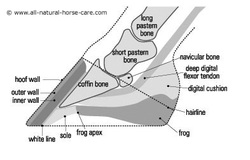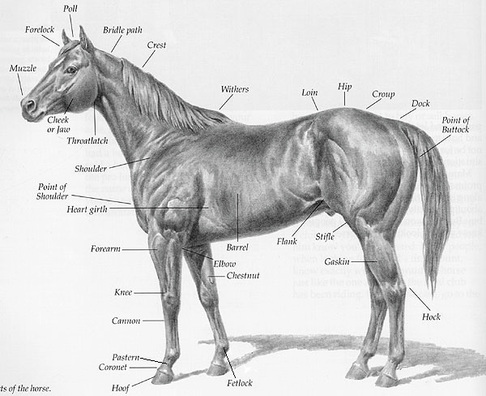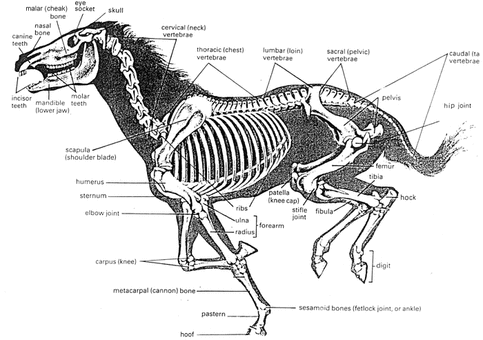Normal Vital Signs of a Horse
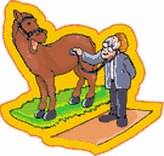
Vital Signs
Adult Horse
* Temerpature: Increses the first four days, then plateaus at 100-102 F
* Heart Rate: 60-110 beats/min.
* Respiratory Rate: 25-60 breaths/min.
Adult Horse
- Temperature: 99.5-101.5 F
- Heart Rate: 32-44 beats/min
- Respiratory Rate: 6-12 breaths/min.
- Capillary Refill Time: 1-2 seconds
- Mucous Membrane Color: Pale Pink
- Gut Sounds: Always Present
* Temerpature: Increses the first four days, then plateaus at 100-102 F
* Heart Rate: 60-110 beats/min.
* Respiratory Rate: 25-60 breaths/min.
How to Age a Horse
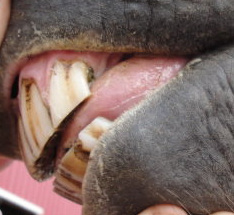
What Is A Galvayne's Groove? A Galvayne's groove is a dark or brownish groove in the upper corner incisor teeth of horses. It is only visible in horses of a certain age, and depending on whether or not it can be seen, how long it is, and where it is (at the top of the tooth or at the bottom) it may be helpful in determining a horses' age.
Determining the age of a horse by its teeth must take into account a wide variety of factors, but even then there are many horses whose age cannot be accurately determined by their teeth. Simply put, while there are guidelines about how teeth should look in a horse at any given age, teeth sometimes lie. Environmental factors, diet, management practices, breed, individual variances, age (it is generally more accurate to age a horse younger than age 9 by its teeth than an older horse), and more can all cause a horse's teeth to inaccurately represent how old a horse actually is.
When using teeth to try to determine the age of a horse older than 10 years, the Galvayne's groove is one of the indicators many horsemen will use. In the text and photos below we explain what a Galvayne's groove is, show several photos of Galvayne's grooves in different horses, and explain what it is expected (but not guaranteed) to look like when a horse is a certain age.
Determining the age of a horse by its teeth must take into account a wide variety of factors, but even then there are many horses whose age cannot be accurately determined by their teeth. Simply put, while there are guidelines about how teeth should look in a horse at any given age, teeth sometimes lie. Environmental factors, diet, management practices, breed, individual variances, age (it is generally more accurate to age a horse younger than age 9 by its teeth than an older horse), and more can all cause a horse's teeth to inaccurately represent how old a horse actually is.
When using teeth to try to determine the age of a horse older than 10 years, the Galvayne's groove is one of the indicators many horsemen will use. In the text and photos below we explain what a Galvayne's groove is, show several photos of Galvayne's grooves in different horses, and explain what it is expected (but not guaranteed) to look like when a horse is a certain age.
Equine Tooth Problems & Dental Care
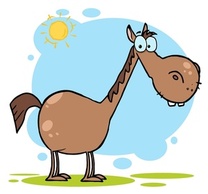
The Horses Teeth
The only time many owners look in their horses' mouth is to check age or to give a dewormer, but it is important to pay as much attention to our horses' dental health as we do to other areas of equine care. Tooth problems in horses are common because their teeth never stop growing. The majority of horses have poor mouths as a result of irregular
wear.
The signs of neglecting the horse's mouth could include:
1) Discomfort while eating. The horse will drop a lot of feed while chewing, or turn his head to one side while chewing.
Some horses may even become timid about eating, appearing to have less of an appetite.
2) Presence of whole corn or other undigested grains in the manure due to improper chewing. This can result in loss
of nutrients for the horse making it unthrifty and unhealthy.
3) Avoidance of the bit, or head tossing.
4) Poor athletic performance
5) Behavioral problem
6) Poor coat and condition
7) Colic can also be caused by bad teeth
Regular Dental Exams
Horses, like people, have two sets of teeth: "deciduous" (temporary) teeth, also known as milk teeth, and permanent
teeth. The milk teeth are smaller, smoother and whiter than permanent adult teeth that replace them. Foals begin to
get teeth within a few weeks of life and by 9 months they have a full set of "deciduous" (temporary) teeth, numbering 24.
These first teeth are sequentially replaced by permanent teeth over the next five or six years. After that point, mature
teeth continue to grow, wear and gradually wear out over the course of the horse's life. The adult teeth are strong, large
and yellowish in color. By the time a horse is six years old, he will have a full set permanent teeth.
An oral exam is the best way to check for dental problems. Your veterinarian needs to provide regular dental examinations
in the interest of maintaining the good health of your horse. Today we recommend that horses begin to have their teeth
checked for uneven wear as yearlings and that they are checked every six months for the rest of their lives. This routine
is beneficial in improving food utilization and therefore general health.
If the horse does not have regular dental check-ups his teeth become so uneven it makes it difficult for the animal to do
an adequate job of grinding food. Horses chew their food by grinding their teeth from side to side. Incomplete sideways
movement results in sharp edges forming along the cheek surface (outside) of the upper teeth and the tongue surface (inside)
of the lower teeth. This causes their teeth to wear down on one side of the upper jaw and the opposite side of the lower jaw.
A ridge is left which becomes very sharp and can cut your horse's tongue or cheeks creating sores that the bit may come in
contact with. Or the edges of the tooth can elongate and become very sharp, cutting into the opposing cheek and gums
causing sores and ulcers.
Also, many horses are not exposed to a natural grazing position, when eating from raised mangers and hayracks. This
produces a difference in the rotation of the jaw during chewing, which can also lead to the development of hooks and sharp
edges.
Due to trauma, such as a kick or a fall, horses can even lose a tooth occasionally. This gives the opposing tooth nothing
to wear against, and it will continue to grow out from the jaw. In severe cases, this unopposed tooth will even keep growing
into the empty space left by the lost tooth. This can bind the jaw movement, making it very difficult for the horse to chew.
FLOATING
A vet should file any ridges or points down at least once a year. This procedure is called "floating the teeth". Veterinarians
use a metal speculum or mouth gag to aid in the examination of the teeth and gums. If points are found, your vet will file the
sharp edge smooth using a number of tools called floats.
Bit Problems
Before introducing the bit to any horse it is essential that his teeth be in optimum condition. It is sometimes
necessary to remove enough of the tooth surfaces by "floating", to prevent teeth form contacting one another at all because
some snaffle bits force a portion of the cheeks between these teeth. It is not difficult to imagine how laceration of these
tissues may cause tenderness in the mouth which could develop into resentment to the bit.
Whenever there is a bit problem first check the condition of your horse's teeth. The most common tooth culprit is the wolf teeth.
Wolf teeth are much smaller and sharper than the rest making them very easy to spot. The wolf teeth are located in front of the
first molar of the back set of teeth. This area is very close to where the mouth piece of a bit will lay. The bit coming in contact
with the wolf teeth can be very painful to a horse. If your horse has wolf teeth a veterinarian can easily remove them.
Dental Exams Vary With Horse's AgeThe dentistry procedures performed on your horse vary according to the horse's age. Severe dental problems are frequently
seen in older horses and are a prime cause of poor weight, poor coat and general lack of condition.
But young horses can have dental problems as well.
Foals
Recognition of congenital abnormalities such as "parrot mouth" or "sow mouth" begin at an early age. Both conditions are
thought to be inherited and are considered an unsoundness. Depending on the degree of contact between between the front
teeth, surgical treatment can be performed in cases of "parrot mouth" provided the foal is under six months of age. Surprisingly,
sharp edges can occur with the baby teeth at this early age and floating may be required.
Yearlings and Two Year Olds
Wolf teeth should be extracted before any training with the bit is started. These are small teeth with short roots sitting against
the front of the upper cheek teeth. They serve no functions (similar to our wisdom teeth) other than to cause irritation when the
bit sits against them. If the wolf teeth are displaced or delayed in eruption, interference with the bit may also occur.
Three Year Olds
Deciduous (baby) teeth can be so firmly lodged that the underlying permanent teeth become impacted. Food lodges in between
causing discomfort and infection. This occurs more often with deciduous cheek teeth commonly referred to as "caps". It is not
uncommon to have to reexamine a 3 year olds mouth repetitively in order to remove 2-3 sets of caps as they become ready since
they may shed a total of eight to twelve caps and four to six incisors (front teeth).
Four Year Olds
If not shed late in their 3 year old year the caps from the third set of cheek teeth become ready for extraction.
Impacted teeth may become infected. The infection may extend into the jaw or sinuses. As in three year olds, removal of caps
and floating (removal of sharp edges) is performed in this age group.
Five Years and Older
Dentistry in this age group includes removal of hooks present on the first and last cheek teeth, floating of sharp edges and
"rounding" of the first cheek teeth in performance horses to provide comfortable "bitting". This "performance floating" prevents
ulcers or cuts from developing by ensuring a smooth contact between the cheeks or tongue against the first cheek teeth.
The abnormalities encountered in the aged horse include uneven wear resulting in weave mouth and/or hooks on the first and
last cheek teeth, gingivitis, abscesses and loss of teeth. All these conditions can seriously affect the way the horses chews and
digests food. Weight loss or colic may result if left untended.
Dentistry for the adult horse should be performed on an annual basis and should include biannual oral exams and a thorough
float yearly.
.
The only time many owners look in their horses' mouth is to check age or to give a dewormer, but it is important to pay as much attention to our horses' dental health as we do to other areas of equine care. Tooth problems in horses are common because their teeth never stop growing. The majority of horses have poor mouths as a result of irregular
wear.
The signs of neglecting the horse's mouth could include:
1) Discomfort while eating. The horse will drop a lot of feed while chewing, or turn his head to one side while chewing.
Some horses may even become timid about eating, appearing to have less of an appetite.
2) Presence of whole corn or other undigested grains in the manure due to improper chewing. This can result in loss
of nutrients for the horse making it unthrifty and unhealthy.
3) Avoidance of the bit, or head tossing.
4) Poor athletic performance
5) Behavioral problem
6) Poor coat and condition
7) Colic can also be caused by bad teeth
Regular Dental Exams
Horses, like people, have two sets of teeth: "deciduous" (temporary) teeth, also known as milk teeth, and permanent
teeth. The milk teeth are smaller, smoother and whiter than permanent adult teeth that replace them. Foals begin to
get teeth within a few weeks of life and by 9 months they have a full set of "deciduous" (temporary) teeth, numbering 24.
These first teeth are sequentially replaced by permanent teeth over the next five or six years. After that point, mature
teeth continue to grow, wear and gradually wear out over the course of the horse's life. The adult teeth are strong, large
and yellowish in color. By the time a horse is six years old, he will have a full set permanent teeth.
An oral exam is the best way to check for dental problems. Your veterinarian needs to provide regular dental examinations
in the interest of maintaining the good health of your horse. Today we recommend that horses begin to have their teeth
checked for uneven wear as yearlings and that they are checked every six months for the rest of their lives. This routine
is beneficial in improving food utilization and therefore general health.
If the horse does not have regular dental check-ups his teeth become so uneven it makes it difficult for the animal to do
an adequate job of grinding food. Horses chew their food by grinding their teeth from side to side. Incomplete sideways
movement results in sharp edges forming along the cheek surface (outside) of the upper teeth and the tongue surface (inside)
of the lower teeth. This causes their teeth to wear down on one side of the upper jaw and the opposite side of the lower jaw.
A ridge is left which becomes very sharp and can cut your horse's tongue or cheeks creating sores that the bit may come in
contact with. Or the edges of the tooth can elongate and become very sharp, cutting into the opposing cheek and gums
causing sores and ulcers.
Also, many horses are not exposed to a natural grazing position, when eating from raised mangers and hayracks. This
produces a difference in the rotation of the jaw during chewing, which can also lead to the development of hooks and sharp
edges.
Due to trauma, such as a kick or a fall, horses can even lose a tooth occasionally. This gives the opposing tooth nothing
to wear against, and it will continue to grow out from the jaw. In severe cases, this unopposed tooth will even keep growing
into the empty space left by the lost tooth. This can bind the jaw movement, making it very difficult for the horse to chew.
FLOATING
A vet should file any ridges or points down at least once a year. This procedure is called "floating the teeth". Veterinarians
use a metal speculum or mouth gag to aid in the examination of the teeth and gums. If points are found, your vet will file the
sharp edge smooth using a number of tools called floats.
Bit Problems
Before introducing the bit to any horse it is essential that his teeth be in optimum condition. It is sometimes
necessary to remove enough of the tooth surfaces by "floating", to prevent teeth form contacting one another at all because
some snaffle bits force a portion of the cheeks between these teeth. It is not difficult to imagine how laceration of these
tissues may cause tenderness in the mouth which could develop into resentment to the bit.
Whenever there is a bit problem first check the condition of your horse's teeth. The most common tooth culprit is the wolf teeth.
Wolf teeth are much smaller and sharper than the rest making them very easy to spot. The wolf teeth are located in front of the
first molar of the back set of teeth. This area is very close to where the mouth piece of a bit will lay. The bit coming in contact
with the wolf teeth can be very painful to a horse. If your horse has wolf teeth a veterinarian can easily remove them.
Dental Exams Vary With Horse's AgeThe dentistry procedures performed on your horse vary according to the horse's age. Severe dental problems are frequently
seen in older horses and are a prime cause of poor weight, poor coat and general lack of condition.
But young horses can have dental problems as well.
Foals
Recognition of congenital abnormalities such as "parrot mouth" or "sow mouth" begin at an early age. Both conditions are
thought to be inherited and are considered an unsoundness. Depending on the degree of contact between between the front
teeth, surgical treatment can be performed in cases of "parrot mouth" provided the foal is under six months of age. Surprisingly,
sharp edges can occur with the baby teeth at this early age and floating may be required.
Yearlings and Two Year Olds
Wolf teeth should be extracted before any training with the bit is started. These are small teeth with short roots sitting against
the front of the upper cheek teeth. They serve no functions (similar to our wisdom teeth) other than to cause irritation when the
bit sits against them. If the wolf teeth are displaced or delayed in eruption, interference with the bit may also occur.
Three Year Olds
Deciduous (baby) teeth can be so firmly lodged that the underlying permanent teeth become impacted. Food lodges in between
causing discomfort and infection. This occurs more often with deciduous cheek teeth commonly referred to as "caps". It is not
uncommon to have to reexamine a 3 year olds mouth repetitively in order to remove 2-3 sets of caps as they become ready since
they may shed a total of eight to twelve caps and four to six incisors (front teeth).
Four Year Olds
If not shed late in their 3 year old year the caps from the third set of cheek teeth become ready for extraction.
Impacted teeth may become infected. The infection may extend into the jaw or sinuses. As in three year olds, removal of caps
and floating (removal of sharp edges) is performed in this age group.
Five Years and Older
Dentistry in this age group includes removal of hooks present on the first and last cheek teeth, floating of sharp edges and
"rounding" of the first cheek teeth in performance horses to provide comfortable "bitting". This "performance floating" prevents
ulcers or cuts from developing by ensuring a smooth contact between the cheeks or tongue against the first cheek teeth.
The abnormalities encountered in the aged horse include uneven wear resulting in weave mouth and/or hooks on the first and
last cheek teeth, gingivitis, abscesses and loss of teeth. All these conditions can seriously affect the way the horses chews and
digests food. Weight loss or colic may result if left untended.
Dentistry for the adult horse should be performed on an annual basis and should include biannual oral exams and a thorough
float yearly.
.
Sole View of Front Hoof
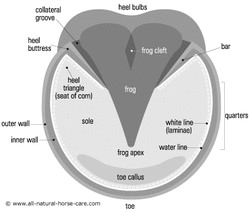
Note the following points:
- Wide, fat frog.
- Tight white line.
- Strong, thick hoof walls - with the inner wall being thicker.
- Bars end approximately halfway down the frog.
- The heel buttresses are back towards the rear of the frog.
- The hoof ratio is 65:35 (from the rear of the hoof to the widest point; and from the widest point to the break over).
Sole View of Rear Hoof
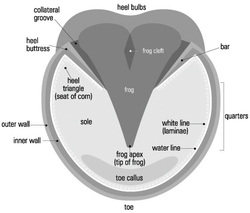
The rear hoof is more oblong in shape and has a slightly pointed toe compared to the front hoof. This is because the rear hooves are used to propel the horse forward and so the point helps the hoof dig into the ground to provide more push.
Voice For Horses Rescue Network
PO Box 566
Toledo, Ohio 43697-0566
(419) 247-0025
[email protected]
This site and it's content are Copyright Voice For Horses Rescue Network 1999-2011 All Rights Reserved, No picture can be reproduced or used without the express and written permission ofVFHRN. Any copy or reproducing of photographs will be considered copyright infringement
PO Box 566
Toledo, Ohio 43697-0566
(419) 247-0025
[email protected]
This site and it's content are Copyright Voice For Horses Rescue Network 1999-2011 All Rights Reserved, No picture can be reproduced or used without the express and written permission ofVFHRN. Any copy or reproducing of photographs will be considered copyright infringement

